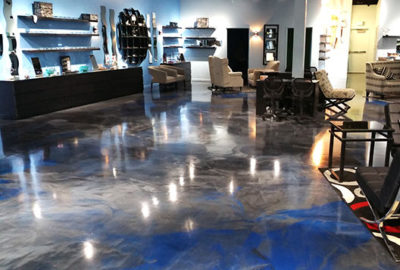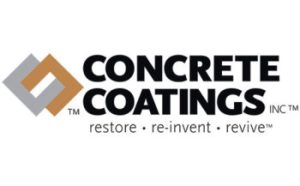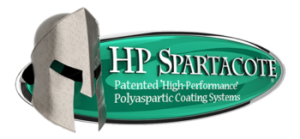Epoxy, Polyurethane or Polyaspartic Coatings
What’s the Difference Between Epoxy, Polyurethane or Polyaspartic Coatings?

About Epoxy Floor Coatings
Epoxy is a thermosetting polymer which is available in three different formulations: water based, solvent based, and 100% solids. These formulations allow for varying degrees of thickness from 3 mils to over 10 mils for a single coating. Epoxy is easy to apply, has special bonding characteristics, and has low VOC. Epoxy bonds extremely well to properly prepared concrete and can sometimes be used as a resurfacing agent for old or worn concrete.
The best epoxy formulations are 100% solids and provide for an extremely hard, thick, and impact resistant surface. This self-leveling thickness contributes to filling in the small hairline cracks and imperfections of the floor as well as providing protection. It also works well against hot tire pick up, scratching, and wear from abrasion. Though some epoxy formulas come with U.V. inhibitors, they will still eventually yellow or amber when exposed to sunlight for any length of time.
Something else to consider is that most epoxy clear coats are not actually crystal clear. Though they have no color, there is a slight yellowish brown tint to the clear epoxy formula.
Typical applications for epoxy sealers include:
- Floors in high-traffic and food-preparation areas
- Cement-based overlays
- Concrete countertops
Like epoxy, polyurethane is a thermosetting polymer and high-performance coating. Polyurethane coatings are mostly used as top coats over Epoxy coatings. They cannot be used as a complete system in itself. Though polyurethane has many advantages over epoxy, it does not bond well to concrete and its thin dry film thickness will not work well as a self-leveling coating. Another consideration is that most polyurethanes are solvent based, meaning they can have high VOC’s, and may require a respirator to apply.
Of the different formulations available, aliphatic polyurethane is the desired choice. Though they are approximately 60% to 70% solids depending on the manufacturer, a polyurethane coating is only about 2 to 3 mils in thickness and can’t be adjusted as with epoxy. Aliphatic polyurethane has more flexibility than epoxy which aids in absorbing impacts better. It is also much more abrasion resistant. The resistance to chemicals is better than epoxy as well and this includes resistance to solvents such as methylene chloride which is the primary ingredient in paint stripper.
Another advantage is that polyurethane is UV stable. This means that it won’t yellow like epoxy does when exposed to small amounts of sunlight over a period of time. The surface of polyurethane is not as hard as epoxy but it is much more scratch resistant, can tolerate larger temperature swings, and handles humidity much better. It is also available in different finishes from satin to very glossy.
Typical applications for polyurethane sealers include:
- Floors in high-traffic areas, to provide good resistance to scuffs and staining
- To enhance the beauty of colored, stamped or exposed-aggregate concrete
- Concrete countertops
Polyaspartic is a coating and sealing product in the same category as epoxy and polyurethane. 100% solids polyaspartic coatings, sealers, and topcoats are low or zero VOC. However, the majority of polyaspartics are not 100% solids but are solvent-based. Solvent-based polyaspartics can be dangerous to inhale, requiring the applicators to wear the appropriate respirator. Polyaspartic coatings possess nearly identical properties as polyurethane coatings. They are long-wearing and abrasion, scratch, chemical, UV and impact resistant. The biggest differences: polyaspartics can be used as a complete flooring system as well as a top coat; they provide faster drying time and high film builds allowing for a much faster return to service. Polyaspartics also resists stains and slightly higher temperatures than other types of coatings.
How long do Polyaspartic Concrete Coatings take to Dry?
- Polyaspartic coatings are designed to exhibit rapid curing capabilities and may dry in a matter of hours or less. Often these concrete floor coating systems provide for next-day return to service. Rapid cure schedule is one of the primary benefits over traditional epoxy coating technology.
Are Polyaspartic Coatings as Durable as Epoxy Coatings?
- Yes. Based on empirical testing data, polyaspartic coatings will offer abrasion resistant capabilities that actually exceed those of typical epoxy systems. Learn more about floor coating adhesion to concrete.
What types of environments are suitable for Polyaspartic Coatings?
- Generally any type of an environment where a resinous concrete floor coating is called for, a polyaspartic coating system may be used. This includes heavy traffic industrial and commercial flooring as well as residential garage floor coatings.
What types of environments are not suitable for Polyaspartic Coatings?
- Polyaspartic coatings are not suitable in situations where a breathable concrete sealer is specified. These applications include exterior stamped concrete or driveways. Polyaspartics are high-performance polymer coatings designed for protection. They will not breathe and can exhibit moisture challenges over time if not used properly.
Can Polyaspartic Coatings be used over an Epoxy Coating?
- Yes, Polyaspartic coatings exhibit superior inter-coat adhesion with epoxy coatings. For old epoxy floor coatings that are still well adhered to the substrate, an installer can apply a new polyaspartic top-coat over that area.
Is a Polyaspartic floor better than an Epoxy or Polyurethane floor?
The two main benefits of Polyaspartic based flooring systems are increased productivity and long-term cost efficiency.
- Typically Epoxy or Polyurethane floors can take 4 or 5 days to install.
- Polyaspartic floors can cure in a matter of hours saving on labor costs.
- Polyaspartic coatings are UV stable and do not yellow as easily (although they will yellow slightly if exposed to direct sunlight for long periods of time.)
- Polyaspartics can be applied around freezing temperatures, making them good for walk-in freezers and the like. However it takes the material a lot longer to cure in colder temperatures. While most polyaspatics cure in 1 to 2 hours in cold areas, some may take up to 4 times as long and can easily be tripled.
- Polyaspartic coatings can be used as top coats over Epoxy coatings (to save costs) or they can be used a complete flooring system.



